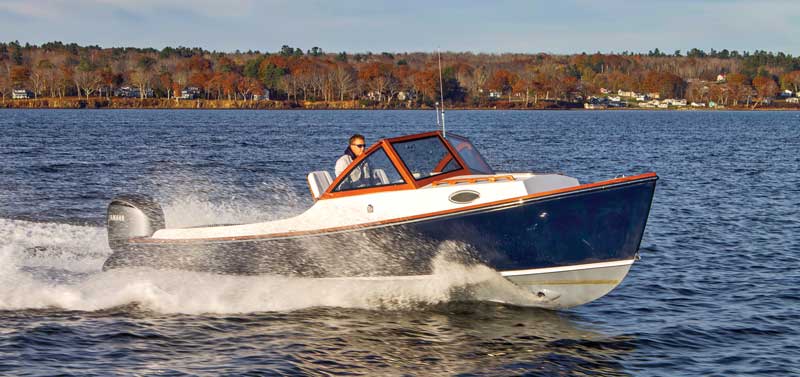 Powered by a 300-hp Yamaha, the New Harbor 28 jumps up on plane and can easily cruise at 20-plus knots. Photo courtesy New Harbor Boats
Powered by a 300-hp Yamaha, the New Harbor 28 jumps up on plane and can easily cruise at 20-plus knots. Photo courtesy New Harbor Boats
Amidst a string of unusually mild early January days, when temperatures in the 40- to 50-degree range were the norm, Mother Nature injected a 24-hour blast of arctic air. Darned if that wasn’t the day we’d arranged for a ride aboard the New Harbor 28, a sharp and salty looking downeast-style powerboat built by Front Street Shipyard in Belfast.
The temperature that morning hovered in the 14-degree range when I set off, though by the time I met my colleague, Ted Ruegg, MBH&H’s publisher, by the shipyard’s Travelift, it had warmed to 16 or so. From where I parked, it was a bracing walk along the waterfront, with a 20-knot northwesterly blasting straight down the Passagassawakeag River.
Inside a toasty conference room in one of Front Street’s metal boat sheds, we met Ed Sutt, founder and owner of New Harbor Boats, his son, Parker, a college sailor on break from Clemson, Front Street design director Craig Picard, and Rob Bodurtha from Charr Custom Boat Co., a consultant on the project.
The New Harbor 28 is a fresh take on the Wasque 26, a 51-year-old John G. Alden Naval Architects design that was first built by Vineyard Yachts and later by CW Hood, in Marblehead, Massachusetts. Vineyard built 30 of them; Hood another 45. From Hood’s shop, the Wasque molds ended up in Rhode Island, where Sutt found them for sale on Craigslist while on a cross country flight, a story detailed by Art Paine in his July/Aug 2023 “Off the Drawing Board.”
Sutt, with a project management background, said he is “naturally obsessed” with boats, and founded the company to breathe new life into a classic design.
So, after buying the molds, he turned to Geoff Van Gorkom, a Rhode Island designer, to make alterations that included removing the Wasque’s inboard diesel compartment, shortening the draft of the keel, and stretching the hull 2 feet and redesigning the transom to accommodate an outboard. One big benefit is the new boat has much more usable space in the cockpit.
Ruegg, whose family owned an early Wasque 26 when he was a kid, confirmed that the inboard compartment in the center of things didn’t leave a lot of room for passengers. And, under way, the engine was loud.
Outside at the dock, the New Harbor looked stunning with its varnished teak windshield and toe rail, blue hull, gleaming stainless ports in the cabintop, a pair of white upholstered teak helm chairs, and a blue-and-white striped cushioned bench seat across the transom. Hull number one, with a price tag of right around $500,000, includes bow thruster, Garmin Electronics, a Fusion stereo system and 300-hp Yamaha outboard. Sutt said there will likely be a stripped-down, basic boat with a smaller motor down the line. But right now, the focus is on selling boat number one.
Onboard, the transom seat opens to provide a ton of space for fenders, lines, and the likes. And the forward cabin, with louvered companionway doors, is deceptively large, with plenty of V-berth space for a weekend getaway. Interior woodwork is cherry.
Despite the cold, the Yamaha sprang to life when Sutt turned the key. Outside the harbor, he tapped the electronic engine control forward and the boat jumped up on plane, the wake flattening to next to nothing. At 3,800 rpm, the speedo read 20 knots, a comfortable cruising pace on a choppy day. Top speed is right around 30 knots.
As we turned to head home and came broadside to the waves, we caught just a few drops of spray, mostly on the windshield, but otherwise we stayed dry as a bone on the upwind dash back to the shipyard.
During my brief stint on the wheel, once I got used to the steering, the boat felt solid and responsive, like a well-mannered cruiser should. On a warmer day, I believe I might have even suggested we take a longer ride.
✮






